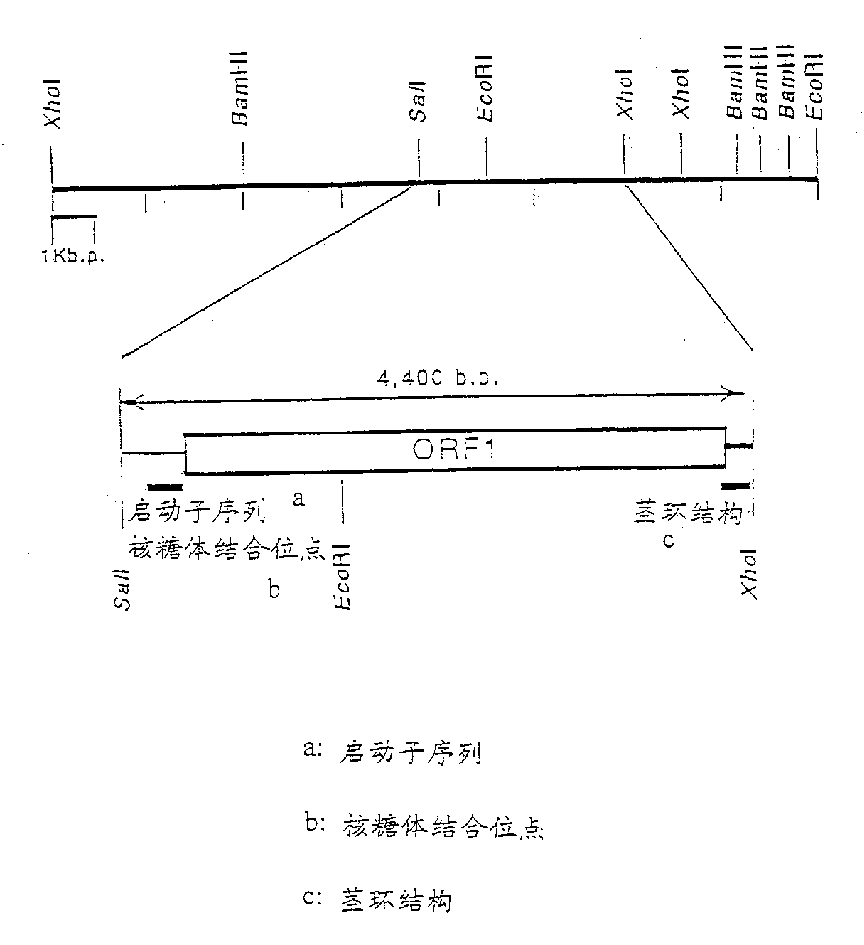Method for stick bacteria capable of producing L-glutaminic acid and producing 1-glutaminc acid
A glutamic acid rod and bacteria technology, applied in the field of L-glutamic acid-producing coryneform bacteria and L-glutamic acid production, can solve the problem of not finding coryneform bacteria mutants and the like
- Summary
- Abstract
- Description
- Claims
- Application Information
AI Technical Summary
Problems solved by technology
Method used
Image
Examples
Embodiment 1
[0100] Example 1: Isolation and structure determination of α-KGDH gene (1) Probe preparation
[0101] Selection of E. coli and B. subtilis α-KGDH E 1 There are regions of high homology between the subunit genes, and the phosphoramidite method was used to synthesize the oligonucleotides given by SEQ ID NOS.3 and 4 in the sequence listing with a DNA synthesizer (Model 394, manufactured by Applied Biosystems).
[0102] Oligonucleotides (0.25 μ mole) were used as primers, and the chromosomal DNA (0.1 μ g) of Bacillus subtilis NA64 was prepared by a common method (this bacterial strain was obtained from Bacillus Genetic Stock Center (Ohio University, U.S.) as a template, and Taq DNA polymerase (2.5 unit) (manufactured by Jiubao Manufacturing Co., Ltd.) was added to 0.1 ml of 10 mM Tris-HCl buffer (pH 8.3) containing 200 μM each of dATP, dCTP, dGTP, dTTp, 50 mM potassium chloride, 1.5 mM magnesium chloride and 0.0001 % gelatin. With the PCR method, each round comprises 94 DEG C for...
Embodiment 2
[0114] Example 2: Increase of α-KGDH activity by expression of α-KGDH gene derived from Brevibacterium lactofermentum ATCC13869 (1) Introduction of α-KGDH gene into Brevibacterium lactofermentum ATCC13869 and AJ11060
[0115] The pHSGS-X plasmid DNA (1 μg) obtained in Example (1) and restriction enzymes SalI and XhoI (20 units each) were mixed with the buffer in (3) in Example (1), and reacted at 37° C. for 3 hours. On the other hand, plasmid pPK4 (refer to Japanese Laid-Open Patent No. 5-7491) DNA (1 μg) and SalI (20 units) that are autonomously transcribed in Brevibacterium bacteria were mixed in the buffer of (3) in Example 1, 37 °C for 3 hours. The two reaction solutions were subjected to phenol extraction and ethanol precipitation by conventional methods. Then, in order to prevent the DNA fragments derived from the plasmid vector from rejoining, the DNA fragments were dephosphorylated by bacterial alkaline phosphatase treatment using the method of Example 1 (3), followed...
reference example 2
[0140] Reference Example 2: Comparison of L-glutamic acid production capacity by adding penicillin
[0141] The effect of α-KGDH gene amplification on L-glutamic acid production was studied by adding penicillin.
[0142] Prepare seed culture with the method identical with reference example 1, seed culture is respectively inoculated to the production medium that has added 0.4 unit / ml penicillin and the production medium that does not add penicillin, makes the dry weight of cell sheet precipitate approximately 2%, cultured with shaking at 31.5°C for 25 hours.
[0143] After the cultivation was completed, the amount of L-glutamic acid accumulated in the culture solution and the concentration of residual glucose were measured in the same manner as in the reference example. The results are given in Table 3. The results showed that the level of α-KGDH activity strongly affected the production of L-glutamic acid after the addition of penicillin.
[0144] table...
PUM
 Login to View More
Login to View More Abstract
Description
Claims
Application Information
 Login to View More
Login to View More - R&D
- Intellectual Property
- Life Sciences
- Materials
- Tech Scout
- Unparalleled Data Quality
- Higher Quality Content
- 60% Fewer Hallucinations
Browse by: Latest US Patents, China's latest patents, Technical Efficacy Thesaurus, Application Domain, Technology Topic, Popular Technical Reports.
© 2025 PatSnap. All rights reserved.Legal|Privacy policy|Modern Slavery Act Transparency Statement|Sitemap|About US| Contact US: help@patsnap.com


